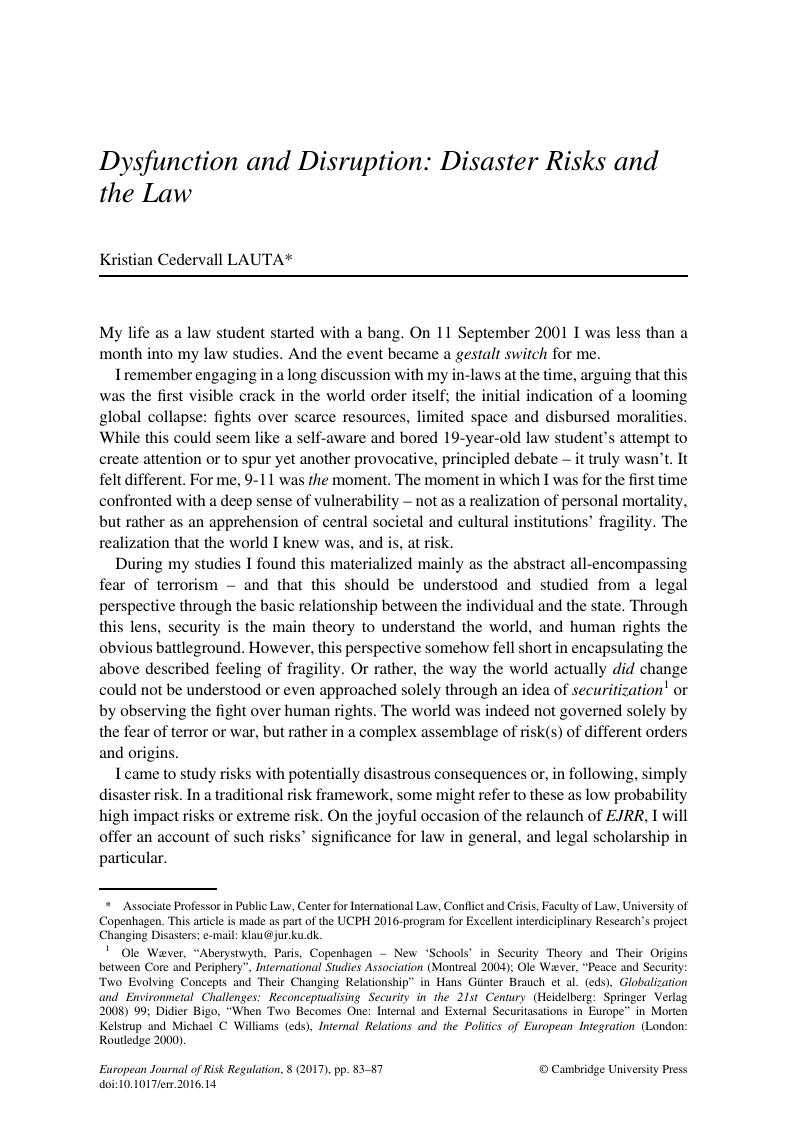No CrossRef data available.
Published online by Cambridge University Press: 26 April 2017

Associate Professor in Public Law, Center for International Law, Conflict and Crisis, Faculty of Law, University of Copenhagen. This article is made as part of the UCPH 2016-program for Excellent interdiciplinary Research’s project Changing Disasters; e-mail: [email protected].
1 Ole Wæver, “Aberystwyth, Paris, Copenhagen – New ‘Schools’ in Security Theory and Their Origins between Core and Periphery”, International Studies Association (Montreal 2004); Ole Wæver, “Peace and Security: Two Evolving Concepts and Their Changing Relationship” in Hans Günter Brauch et al. (eds), Globalization and Environmetal Challenges: Reconceptualising Security in the 21st Century (Heidelberg: Springer Verlag 2008) 99; Didier Bigo, “When Two Becomes One: Internal and External Securitasations in Europe” in Morten Kelstrup and Michael C Williams (eds), Internal Relations and the Politics of European Integration (London: Routledge 2000).
2 See also the German sociologist Niklas Luhman: “risk refers to decisions which accept the chance of possible negative consequences”: Niklas Luhmann, Law as a Social System, ed. Fatima Kastner et al., (Oxford: Oxford University Press 2004) 155.
3 A definition in line with the one applied in the ISO standard for Risk Management ISO31000: “effect of uncertainty on objectives”.
4 Defining disaster is something that takes an entire article on its own. For the purpose of this essay, maybe it would be sufficient to understand this as events or processes with very serious consequences causing death and destruction.
5 Obviously this is an incredibly controversial claim so early in the text, see e.g. otherwise Richard A Posner, Catastrophe : Risk and Response (Oxford: Oxford University Press 2004) 322.
6 See this argument unfolded in Kristian Cedervall Lauta and Michael G Faure, “Disaster Risk Management” in Adam Burgess, Alberto Alemanno, and Jens O Zinn (eds), Routledge Handbook of Risk Studies (London: Routledge 2016) 179.
7 For a more elaborate version of this argument see Kristian Cedervall Lauta, Disaster Law (Routledge 2014).
8 Daniel Farber and Michael Faure (eds), Disaster Law (Edward Elgar Publishing 2010); Michael Faure and Andri Wibisana (eds), Regulating Disasters, Climate Change and Environmental Harm. Lessons from the Indonesian Experience (Cheltenham: Edward Elgar 2013).
9 Daniel Farber et al., Disaster Law and Policy (2nd edn, Wolters Kluwer Law & Business: Aspen Publishers 2010); Rosemary Lyster, Climate Justice and Disaster Law (Cambridge University Press 2016).
10 Robert Verchick, “Disaster Justice” (2012) 23 Duke Environmental Law and Policy Forum; Robert Verchick, Facing Catastrophe (Harvard University Press 2010).
11 Alberto Alemanno (ed.), Governing Disasters – the Challenges of Emergency Risk Regulation (Edvard Elgar 2011).
12 See not least Anne van Aaken’s recent special issue in Global Policy: Janis Antonovic and Anne Van Aaken, “Is International Law Conducive to Prevent Looming Disasters?” (2016) 7(1) Global Policy.
13 Thomas S. Kuhn, The Structure of Scientific Revolutions (2nd edn, University of Chicago Press 1970).
14 For an overview of the impressive body of ongoing and recently decided upon penal cases after disasters, see Denis Binder, “The Increasing Application of Criminal Law to Disasters and Tragedies” (2016) 30(3) Natural Resources and the Environment.
15 See, in this regard, the symposium in EJRR on the so-called L’Aquila Seven, in which several of the authors discuss how law is ill-equipped to deal with the dilemmas posed by the facts of the case, (2014) 2 EJRR.
16 Draft outcome document of the United Nations Conference on Housing and Sustainable Urban Development (Habitat III), A/CONF.226/4, Quito, 17–20 October 2016.
17 The Sendai Framework for Disaster Risk Reduction 2015–2030 was adopted at the Third United Nations World Conference on Disaster Risk Reduction, held 14–18 March 2015 in Sendai, Miyagi, Japan.
18 Addis Ababa Action Agenda of the Third International Conference on Financing for Development (Addis Ababa Action Agenda) Resolution 69/313 adopted by the General Assembly on 27 July 2015.
19 Transforming our world: the 2030 Agenda for Sustainable Development. Resolution 70/1 adopted by the General Assembly on 25 September 2015.
20 The Paris Agreement (2015), available at: <http://unfccc.int/files/essential_background/convention/application/pdf/english_paris_agreement.pdf> (last visited November 2016).
21 See in this context the great work carried out by Martin Rees and his Centre for the Study of Existential Risk at University of Cambridge.
22 See the works of Nick Bostrom and his team at Oxford University.